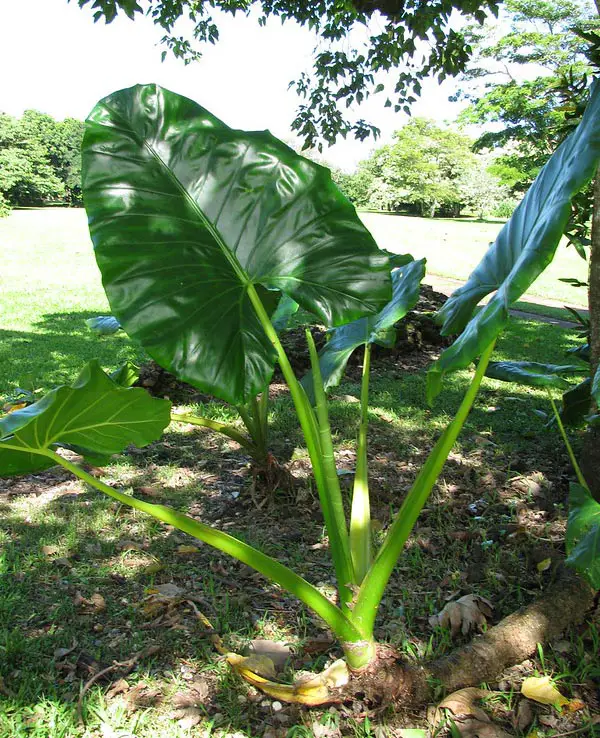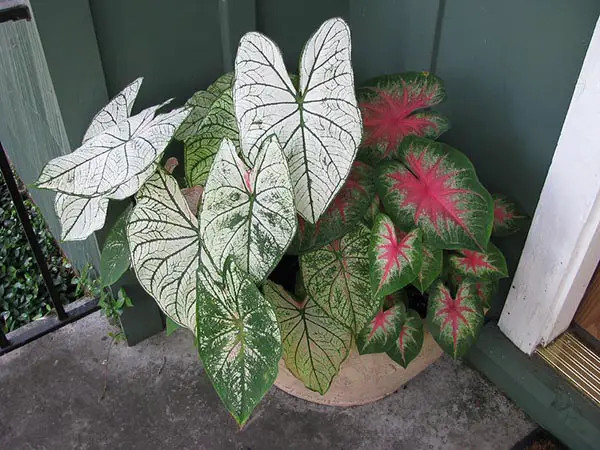Elephant Ear Plants are robust tropical plants that make a wonderful garden display in warm climates, or attractive and decorative houseplants in cold climates. No matter what climate you live in, growing these beautiful large-leaved plants is quite easy. Take a look at this useful guide on how to care for elephant ear plants.

What is an Elephant Ear Plant?
Elephant ear plant is an umbrella term for many plants of the Colocasia, Caladium, Alocasia and Xanthosoma genera, all from the family of Araceae. These plants have large leaves that visually resemble elephant’s ears, hence the name.
The most popular types of elephant ears are certainly Colocasia esculenta, also known as ‘Taro, and Colocasia Gigantea, known as giant elephant ear or Indian Taro. ‘Black Magic’ Colocasia (Colocasia esculenta ‘Black Magic’) is one of the most spectacular varieties prized for its dark purple, almost black leaves.
Another highly renowned variety, and probably the easiest to buy, is African mask plant or Amazon Elephant’s Ear (Alocasia amazonica) with deep green leaves and white veins.
All elephant plants are tropical plants native to rainforests of South America, Central America, subtropical Asia, southeastern Asia, and Eastern Australia, but they are widely naturalized and cultivated in many other tropical and subtropical regions.
What Type of Elephant Ear I Have?
Since all types of elephant ear plants are similar and closely related, sometimes it’s hard to tell the difference between them. However, the difference is mainly botanical, while their growing requirements are pretty much the same.
The main difference between Alocasia and Colocasia is that Alocasia plants have matte leaves pointing up, while Colocasia has more rounded and glossy leaves pointing down. Colocasia also has bigger tubers, with encircled marking. Alocasia’s tubers are smaller and plain. The shape of their leaves is considered to be cordate, or heart-shaped.
Plants of the Caladium and Xanthosoma genera have smaller, arrowhead or shield-shaped leaves directed down. Xanthosoma plants are mainly solid green with less variegation, while Caladiums come in a wider range of colors, often with an interesting variegation or contrasting veins.
Some Xanthosoma varieties resemble unrelated Coleus.
Another important difference is a part of a leaf that is attached to a petiole (the stalk that joins a leaf to a stem). The petiole in Alocasia and Xanthosoma plants is attached at leaf notch, while Colocasia’s petiole is attached bellow leaf notch. Caladiums, on the other hand, can have both types of petiole attachment.
How to Care for All Elephant Ear Plant Types
Elephant ear plants are fairly easy to grow once they’re established. Depending on the climate in your region, you can successfully grow elephant ear plant indoors or outdoors.
In warm climates, elephant plants can be grown outdoors year-round. They are winter-hardy only in the 8-11 hardiness zone.
In cold climates, these plants are usually grown as houseplants. But if you want to grow elephant ears outside in a cold climate, it can be treated as an annual plant. In this case, when the season is over, save the bulbs for the next season. Dig them up before the first frost, as soon as the temperature drops below 40ºF (4ºC). Store them in dark, but warm and dry place, covered in wood cuttings or dry peat moss.
Soil for Elephant Ear Plants
The soil for elephant ear should be moist, rich in organic matter, with 5.5-7.0 pH. Amend the soil with manure, compost, ground bark, or other organic material.
Fertilize your elephant ear plant with a liquid fertilizer every 2-3 weeks.
Water Requirements
There is a slight difference in water requirements within elephant ear types. Colocasia naturally grows in wetlands, so it prefers moist soil and a lot of water. Other species like less water. Alocasia plants like moisture, but they need perfectly drained soil to survive.
Keep a regular watering schedule, never letting the soil to be dry.
Some elephant ear plants can be sensitive to tap water, so use rainwater if possible. You can also let water sit for a few days before watering your elephant ear plants.
Temperature and Light Requirements
Elephant ear plants mostly prefer partial shade but will tolerate full sun. The types with dark-colored variegations prefer sunny positions. These plants are tender perennials sensitive to frost and strong winds, so consider growing them outside only if you live in warm climates.
How to Plant Elephant Ear Bulbs
If you’re planting elephant ear bulbs (tubers) directly into a garden bed, do that after all danger of frost has passed. You can plant them from spring to summer. The soil should be warm – at least 65ºF (18ºC). Choose big, firm, and healthy tubers.
Plant the bulbs 5 inches (12 cm) deep with a pointy side facing up. Leave a proper space between them since elephant ears need room to grow. You can mulch the soil, to maintain soil moisture and keep the weeds down.
If you decide on starting an elephant ear from seed, plant the seeds 4-6 weeks before the average last frost date and transplant the plant when the strong root system is established.

Common Problems with Elephant Ear Plants
Although elephant ears are easy to grow, they may face several problems. Many problems are water-related. Elephant ears don’t like sitting in the water, but they are most likely to be affected by drought.
They are susceptible to spider mites, mealybugs, and aphids, so check your plants’ foliage frequently.
Fungal leaf blight and Phyllosticta leaf spot are the most common diseases in elephant ears. They cause small, circular lesions that may turn yellow or purple, causing an infected leaf to collapse. Apply copper-based fungicide and avoid overwatering.
Other problems that may appear in elephant ears are:
- Brown leaf edges – The plant is probably getting to much sun. Move the plant in a shadier position and avoid direct sunlight.
- Pale leaves – This may indicate a lack of nutrients. Fertilize the plant.
- Curled or wilted leaves – It could be a sign of water deficiency.